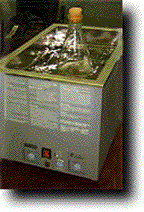The "One Step Growth Curve"
In the 1930's, Emory Ellis and Max Delbrück performed a classic experiment which revealed the fundamental nature of virus replication.
If you'd like to read the paper they published, click on this link (Ellis E.L, Delbruck M. 'The growth of bacteriophage' J.Gen.Physiol. 22: 365-384, 1939).
If not it's OK, just carry on and do the experiment.
Although this experiment involves a bacteriophage, the principles it demonstrates apply to ALL viruses, (but not all viruses show such clear-cut or rapid replication cycles, e.g. HIV).
So how does it work?
 |
- Yesterday evening, I prepared a 100ml culture of Escherichia coli (E.coli ) bacteria. This was grown overnight at 37°C.
- Earlier today, I prepared a sterile 2 litre flask containing 900ml L-broth (bacterial growth medium), 10ml 1M MgSO4, 10ml 1M CaCl2.
(Why is the addition of Mg and Ca necessary?)
- 1 hour ago, I added the overnight E.coli culture to the pre-warmed flask, which has been incubated at 37°C with rapid shaking. The bacteria are now in the log phase (i.e. growing exponentially).
- To start the experiment, I'm just about to take 1ml of the culture (which now contains about 1x109 bacteria) and add 1x1010 plaque forming units (pfu = 'infectious units') of bacteriophage. This will give a multiplicity of infection (m.o.i.) of 10: i.e. 10 virus particles/cell.
- I will incubate this for 1minute at 37°C. (Why?)
- Then I will quickly spin down the cells (discarding the supernatant), resuspend them and add them back to the 1000ml log (exponential) phase culture culture.
This is the most critical part of the whole experiment - and the smart bit that Ellis and Delbrück came up with - since it synchronizes the infection of the cells. (How?)
|
It's important that you understand how this works, so you might want to re-read the above section and think about it for a while.
Click here when you are ready to start


DISCLAIMER © AJC 2002.
